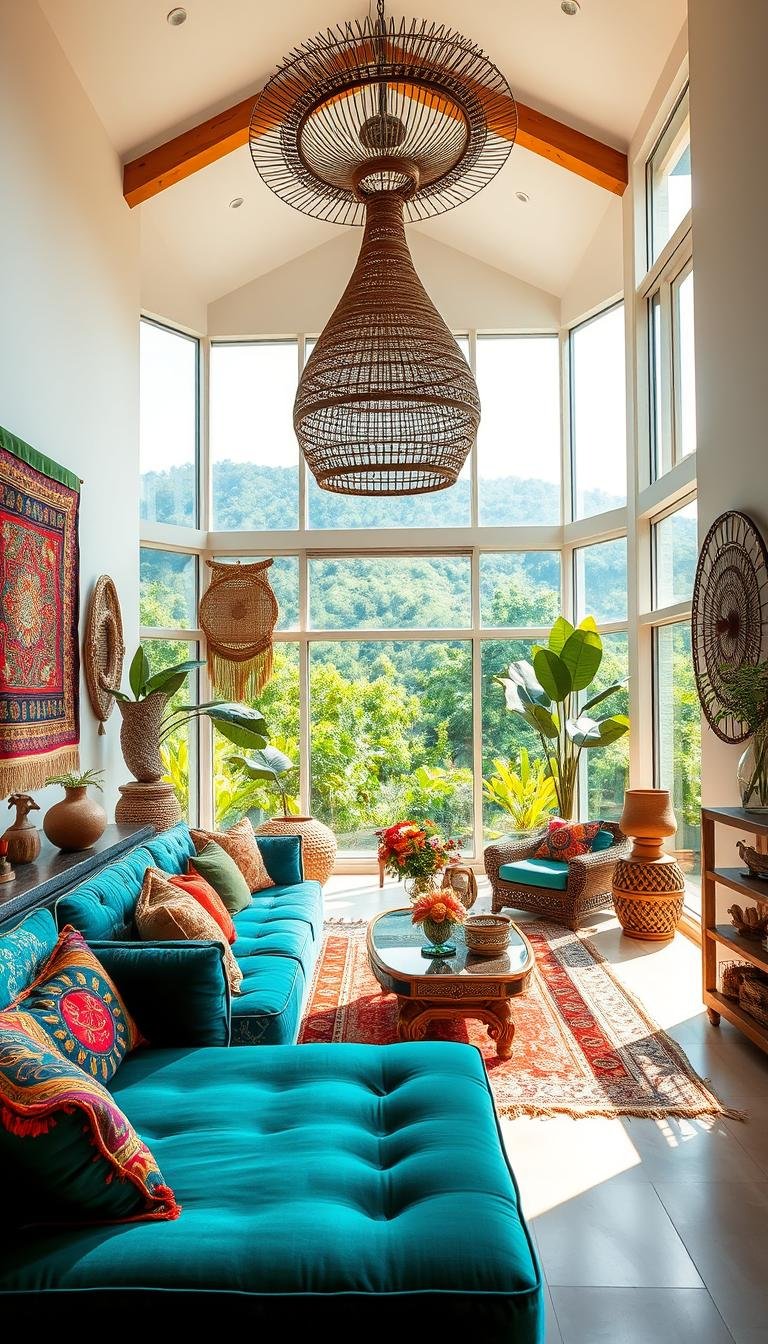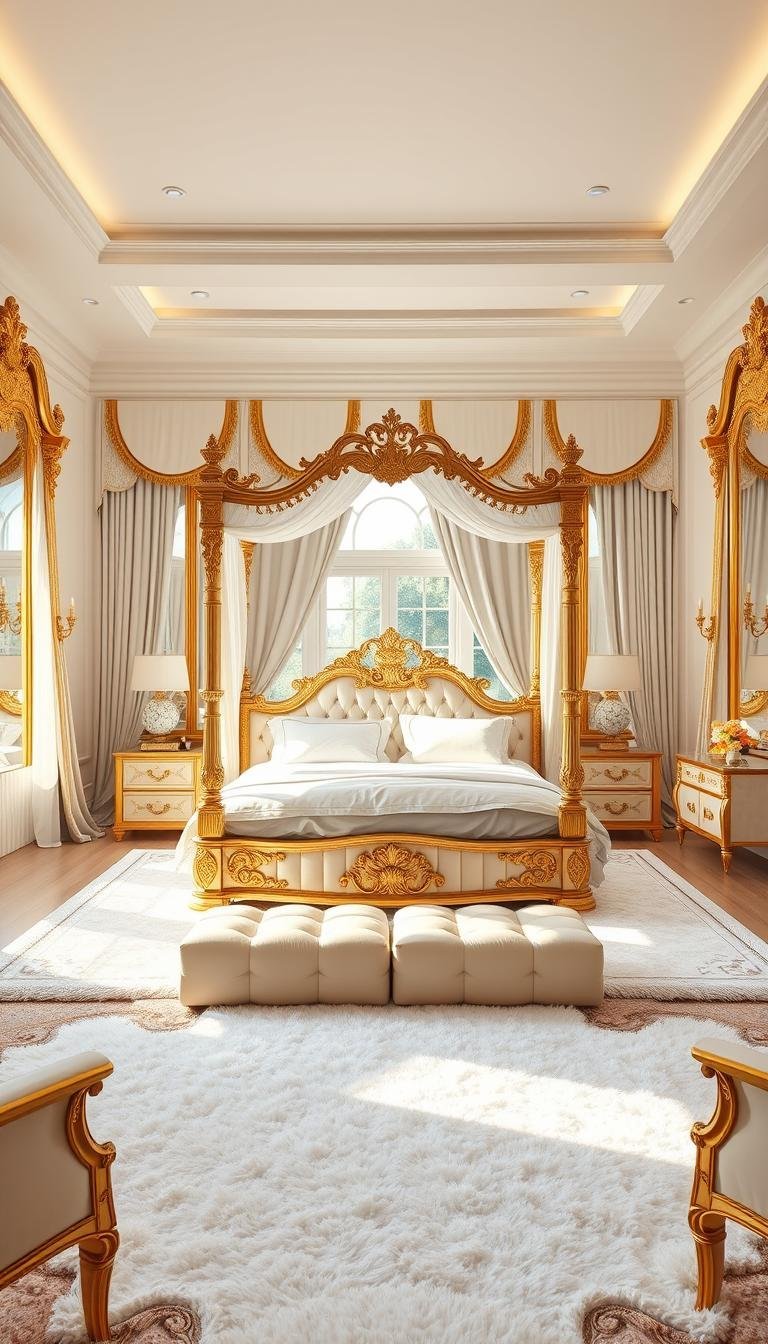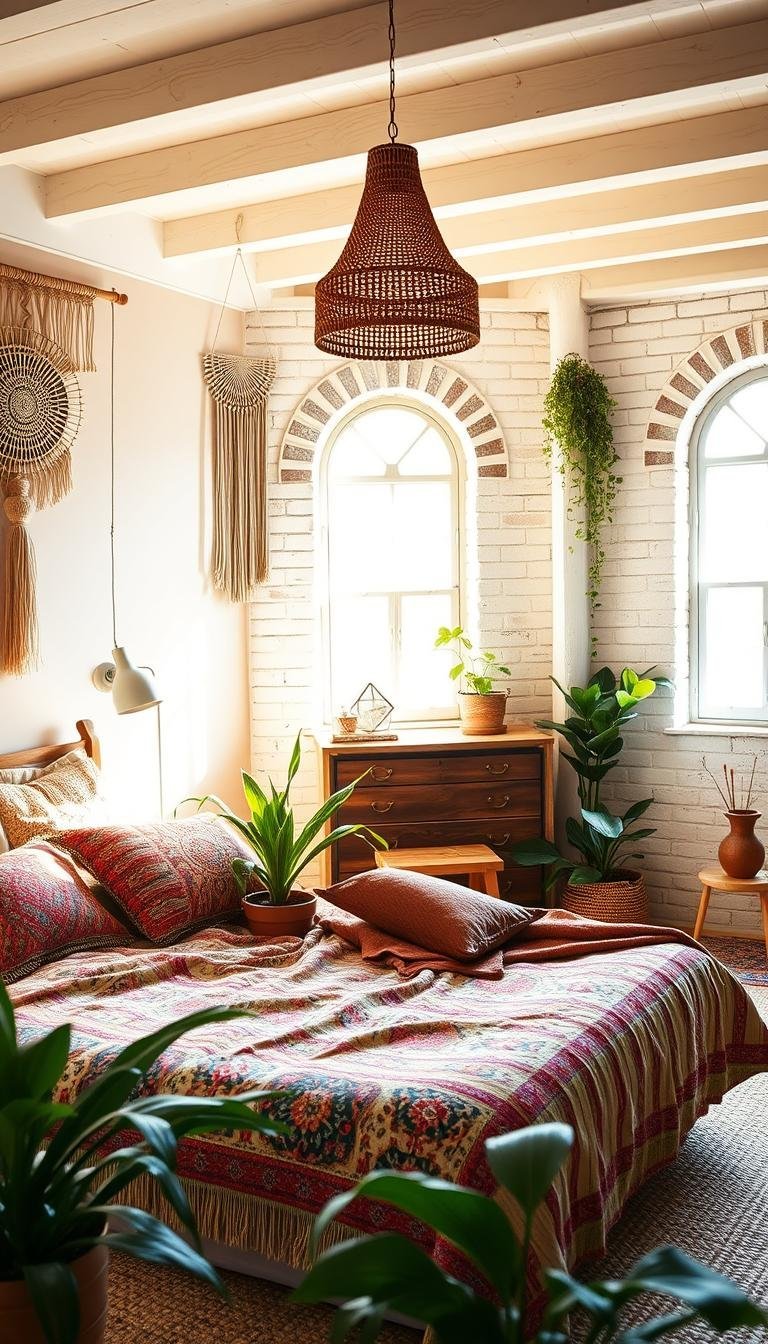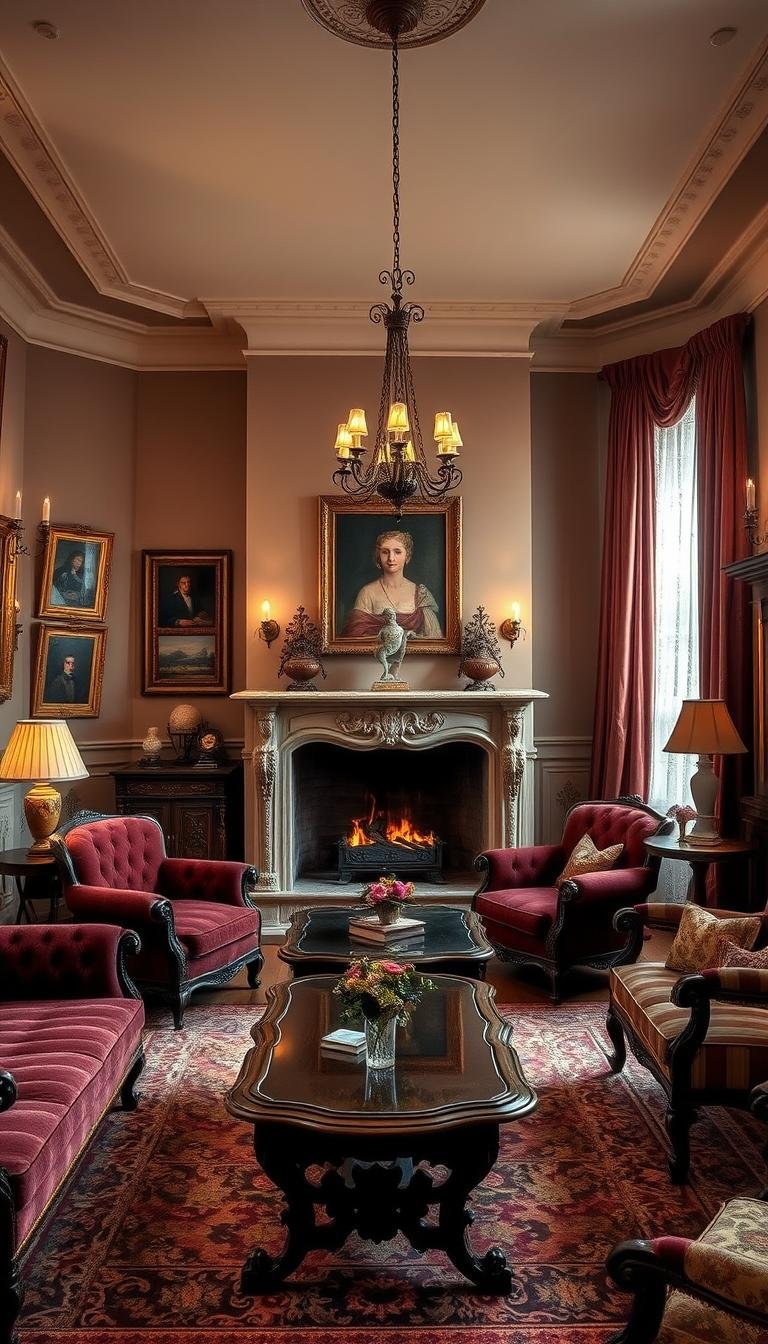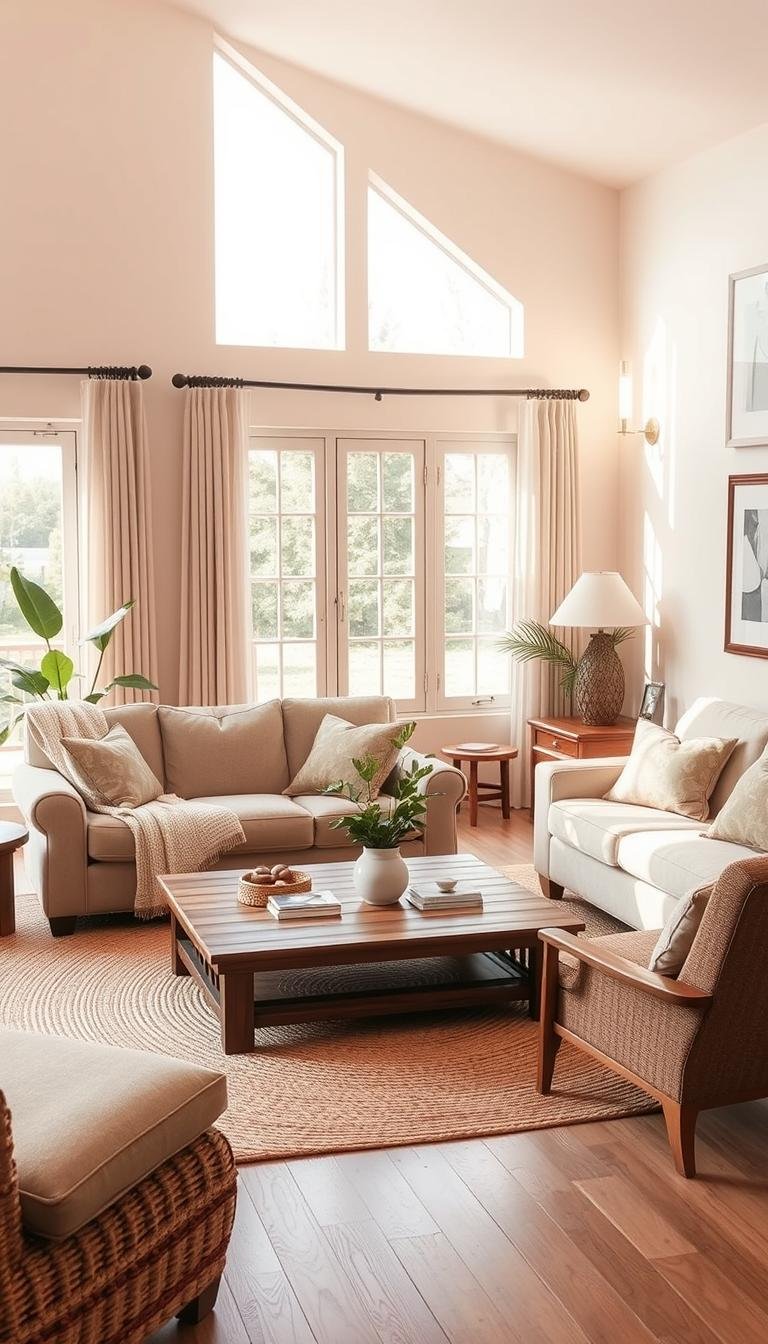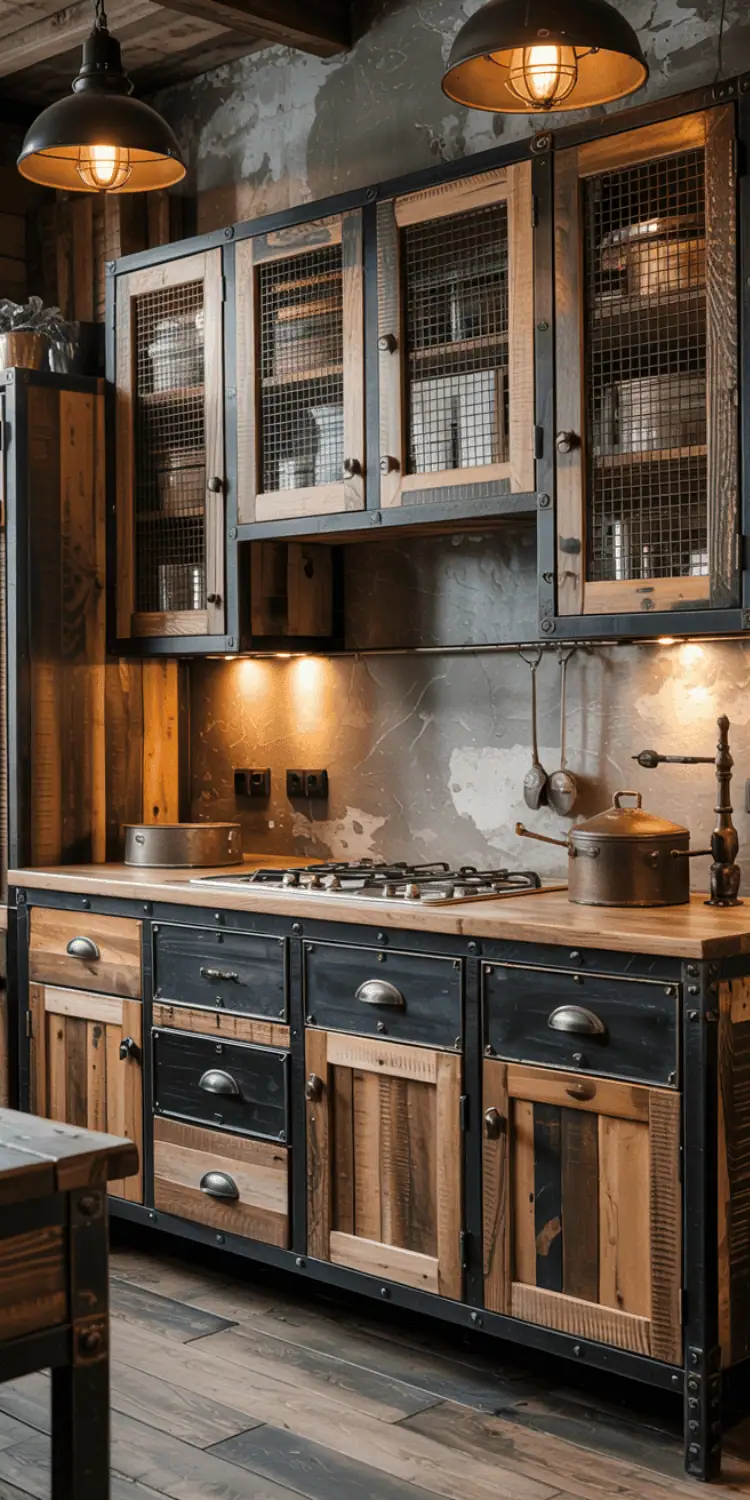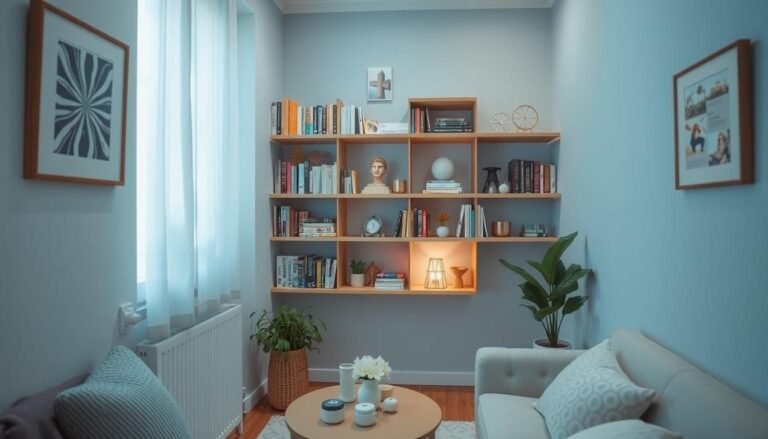This post may contain affiliate links. If you click and buy, we may earn a small commission at no extra cost to you. Learn more.
I’m excited to share the latest trends that bring global style into your home! As a design enthusiast, I love adding elements from different cultures to my decor. This creates a space that’s not only beautiful but also rich in cultural heritage.

Celebrating diversity through ethnic-inspired decor adds depth and character to your living space. By embracing global design aesthetics, you can make your home reflect cultural diversity and your personal style.
In this article, we’ll explore the rich heritage of global design. We’ll also show you how to incorporate it into your home decor. This will make your space truly unique!
Contents
- 1 The Rich Heritage Behind Global Design Aesthetics
- 2 Principles of Ethnic Interior Design That Honor Cultures
- 3 African-Inspired Design Elements and Applications
- 4 Asian Design Philosophies for Modern Homes
- 5 Latin American Vibrancy in Home Decor
- 6 Middle Eastern Opulence and Intricate Patterns
- 7 Indigenous North American Design Elements
- 8 Creating Balanced Fusion Spaces with Ethnic Interior Design
- 9 Sustainable Approaches to Global Design
- 10 Ethnic Design Elements for Different Room Types
- 11 Conclusion: Creating a Home That Honors Global Heritage
The Rich Heritage Behind Global Design Aesthetics
Exploring ethnic interior design reveals a world shaped by rich cultural heritage. The diverse elements in our home decor show the beauty of cultural exchange. They also highlight the importance of keeping traditional design alive.
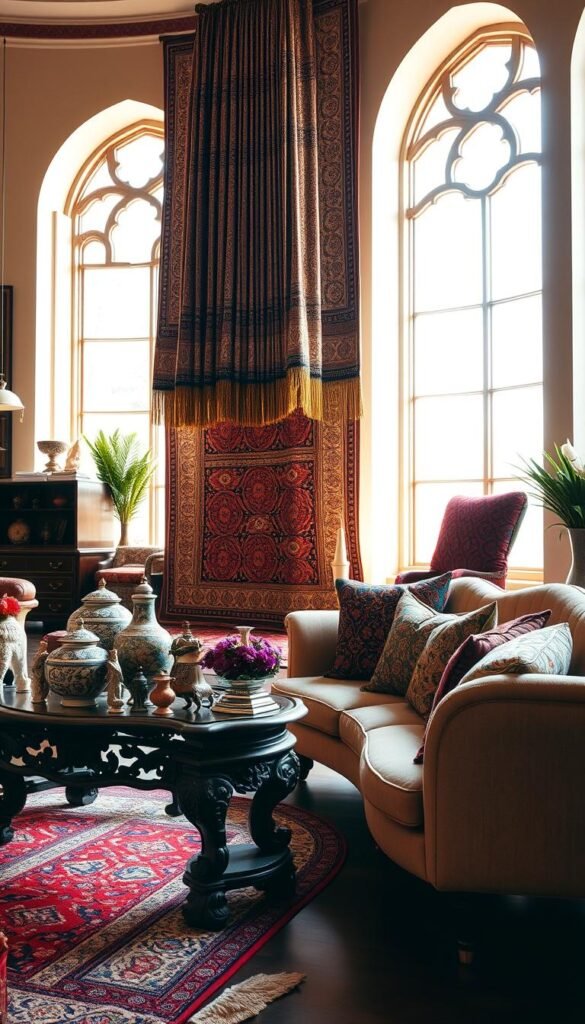
The history of cultural elements in home decor is captivating. It spans centuries, from African textiles to Japanese Zen aesthetics. Each culture has brought its unique view to interior design. By embracing these elements, we can make spaces that reflect our style and celebrate cultural diversity.
The Evolution of Cultural Elements in Home Decor
Cultural elements in home decor have changed a lot over time. Factors like trade, migration, and technology have played a role. For example, traditional African patterns are now popular in modern design, adding authenticity to our homes.
As we draw inspiration from all over, it’s key to understand the history and meaning of these elements. This way, we can truly appreciate their value.
Why Diversity Matters in Interior Design Today
Diversity in interior design is more than just looks. It’s about creating spaces that are inclusive and respectful of different cultures. By using diverse design elements, we can deepen our appreciation for cultural heritage.
In today’s world, diverse interior design is vital. It helps promote understanding and exchange between cultures. This makes our homes more meaningful and connected to the world.
Principles of Ethnic Interior Design That Honor Cultures
Exploring ethnic interior design means understanding the difference between appreciation and appropriation. Using elements from different cultures can make your home more interesting. But, it’s important to do it thoughtfully and with knowledge.
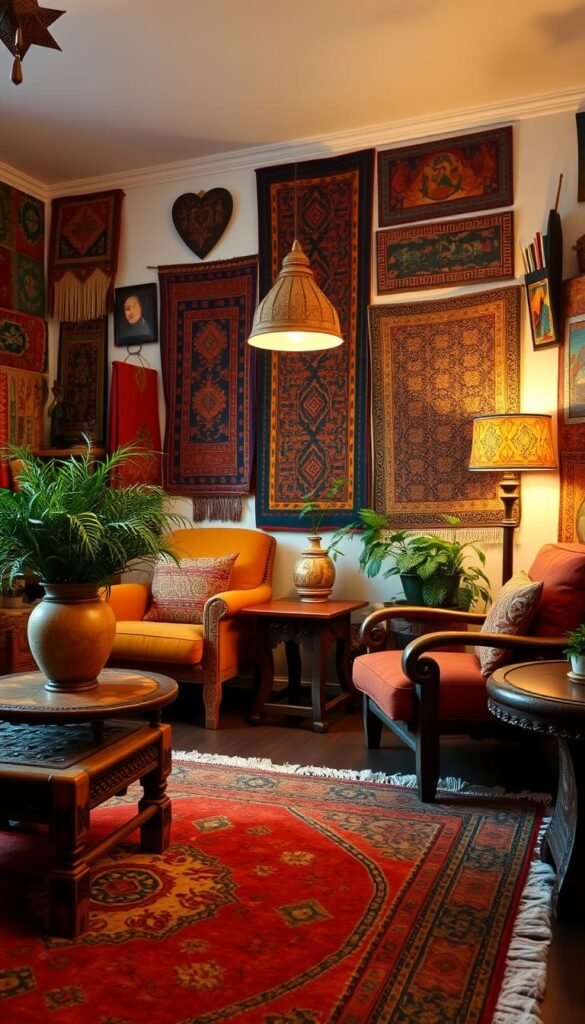
Distinguishing Between Appreciation and Appropriation
Cultural appreciation is about respecting and valuing a design’s cultural background. On the other hand, cultural appropriation happens when elements are used without understanding their true meaning. To avoid this, learn about the cultural background of the items you choose for your ethnic home decor.
Researching Cultural Context Before Decorating
Before adding ethnic elements to your space, learn about their cultural history and meaning. This means understanding the symbols, traditional uses, and stories behind the items. This way, your multicultural design choices will be respectful and well-informed.
Ethical Sourcing of Authentic Pieces
Choosing items ethically is key in ethnic interior design. This means buying directly from artisans or trusted sellers who follow fair trade. This way, you help support the communities where these items come from, preserving their culture and promoting fair trade.
By following these principles, you can create a home that celebrates ethnic home decor while respecting the cultures that inspire it. This thoughtful approach to multicultural design helps us appreciate the diversity that makes our homes richer.
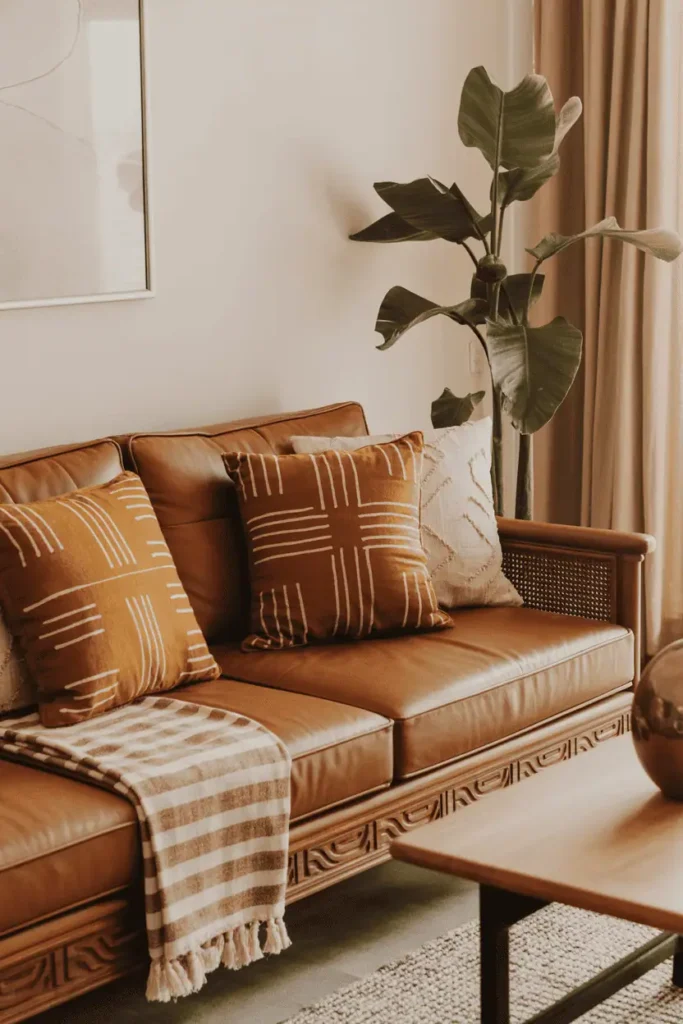
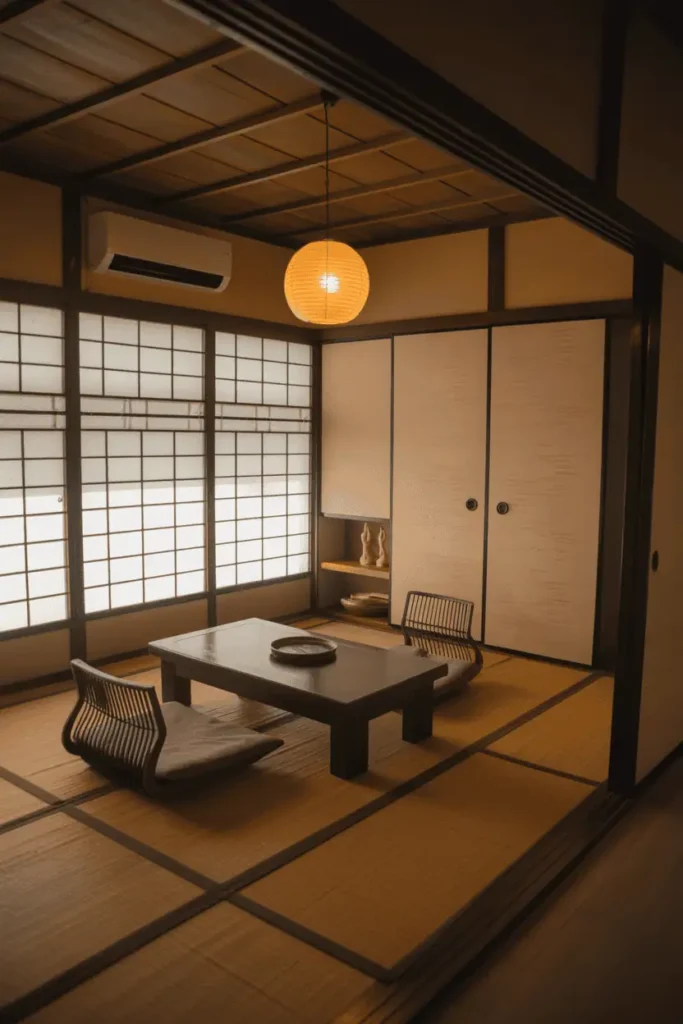
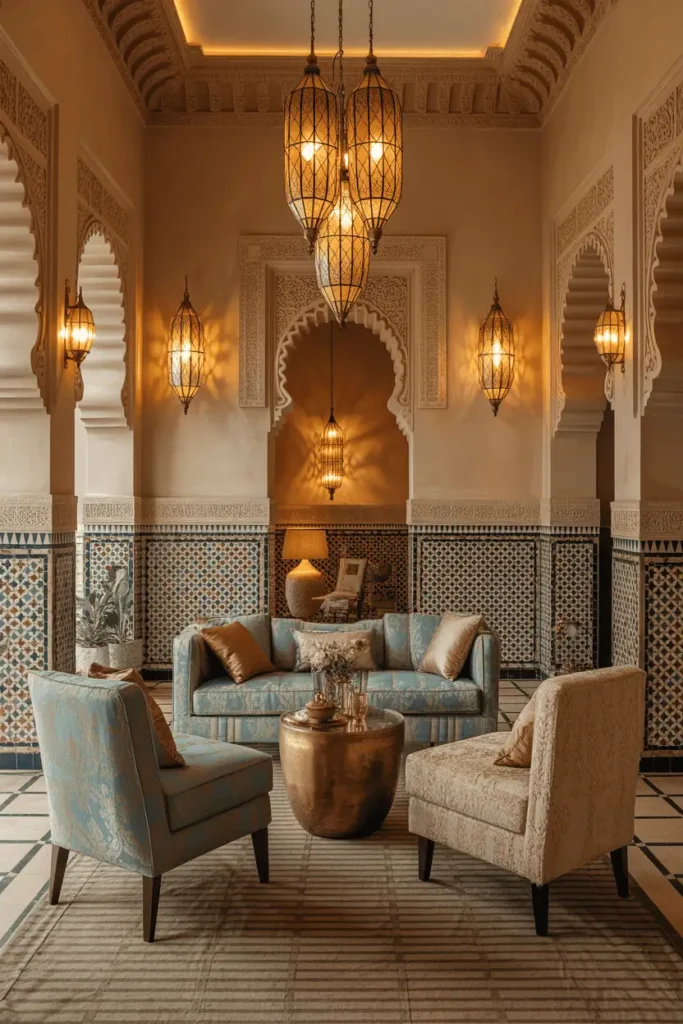
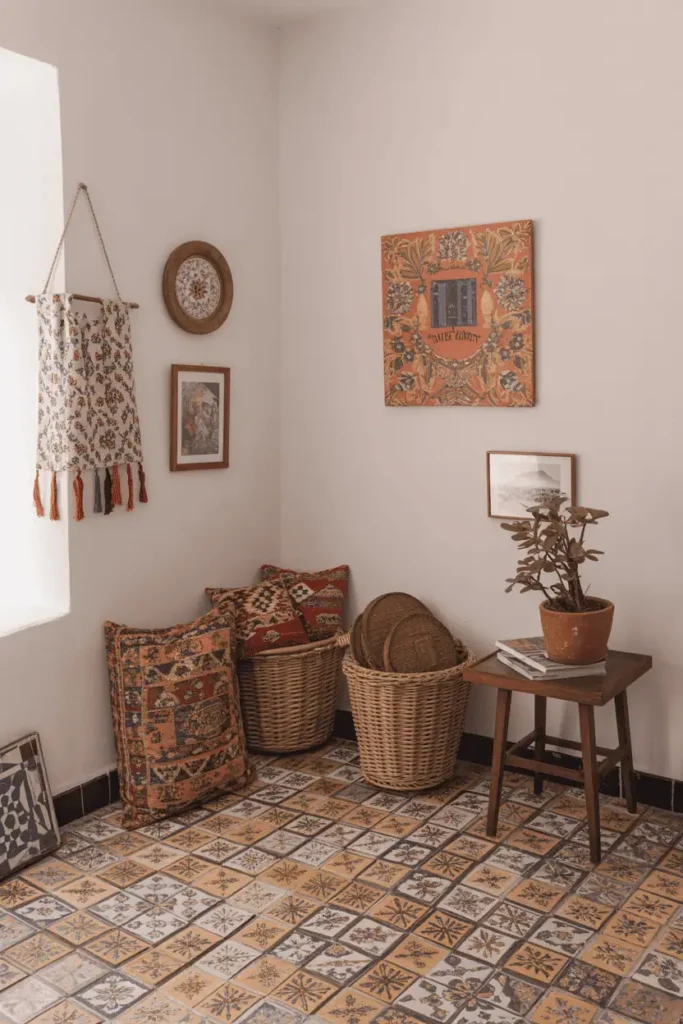
African-Inspired Design Elements and Applications
I’m excited to share how African-inspired elements can transform your living space! African culture is rich in design elements that can elevate your home decor. From vibrant textiles to sculptural furniture, these elements can make your space beautiful and rich in cultural heritage.
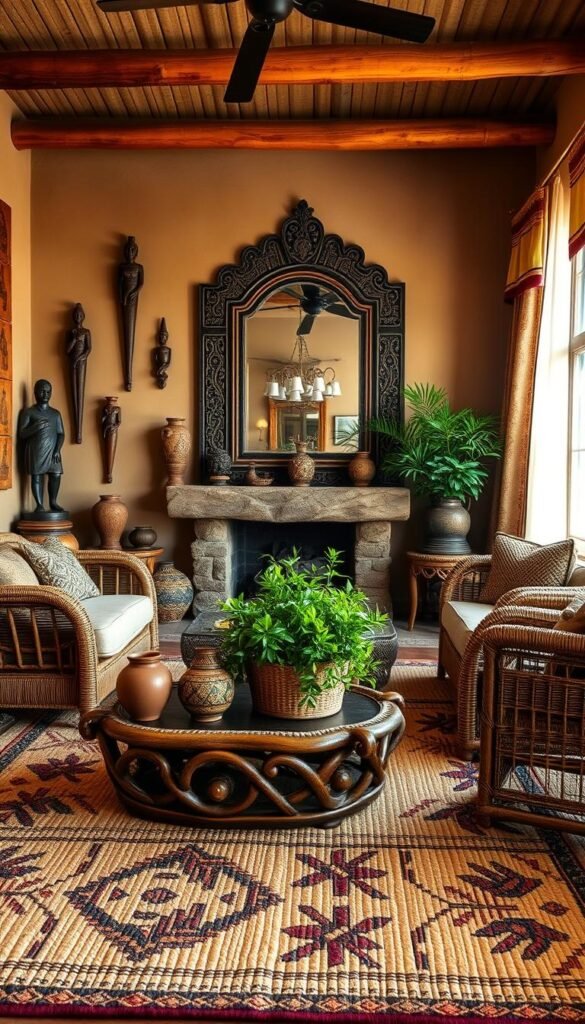
Mud Cloth, Kente, and Tribal Patterns in Textiles
African textiles are known for their bold patterns and vibrant colors. Mud cloth and Kente cloth are two examples of traditional African textiles. They can add a unique touch to your home. Use them in throw pillows, blankets, or even wallpaper.
Sculptural Furniture and Decorative Masks
African design is also known for its sculptural furniture and decorative masks. These pieces can serve as statement items in your home. They add a touch of cultural authenticity. Look for items made from natural materials like wood or clay to bring warmth and texture to your space.
Earthy Color Palettes and Natural Materials
African-inspired design often features earthy color palettes and natural materials. Consider incorporating terracotta tones, deep reds, and earthy browns into your decor. Use natural materials like wood, bamboo, or rattan to add depth and texture to your space.
Asian Design Philosophies for Modern Homes
Asian design philosophies offer a wide range of styles for your home. They let you create a modern space that shows your style and respects Asian culture.
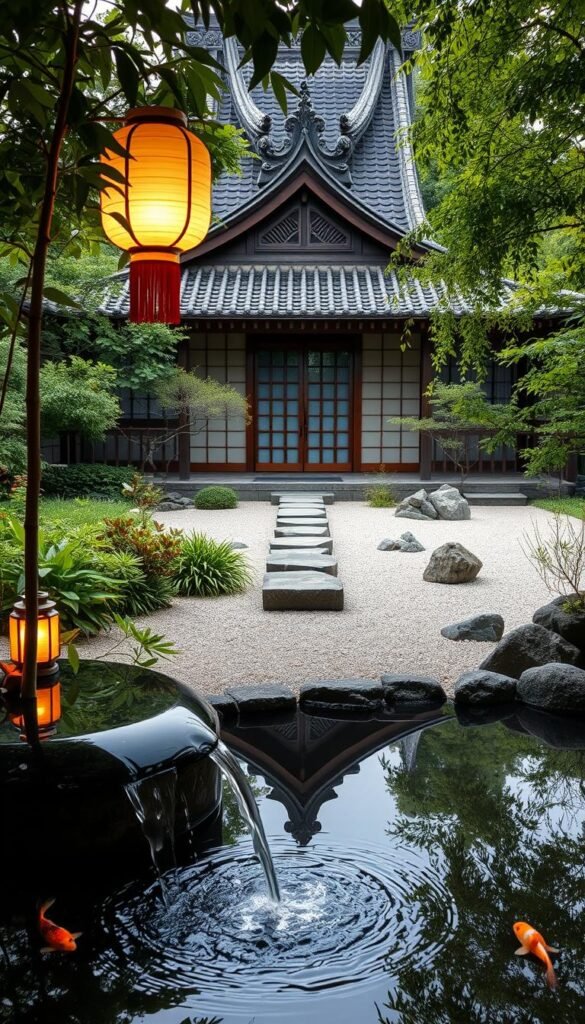
Asian cultures have a long history of design. These philosophies can make your home unique and peaceful. Let’s look at some of these philosophies and how they can decorate your home.
Japanese Minimalism and Zen Aesthetics
Japanese design is all about simplicity and natural materials. Use wood and bamboo, and choose simple colors. Adding Zen elements like a meditation spot or a water feature can make your home feel calm.
Chinese Traditional Elements in Contemporary Spaces
Chinese design is known for its detailed patterns and bold colors. To add this to your home, use traditional Chinese items like lacquer furniture and silk. You can also use Chinese patterns in your decor to add cultural touch.
Indian Color Theory and Textile Applications
Indian design is famous for its bright colors and rich textiles. Use bold colors and add textiles like embroidered fabrics. Indian patterns in your decor can add color and cultural flair.
Asian design philosophies can make your home stylish and meaningful. Whether you like Japanese simplicity, Chinese elegance, or Indian vibrancy, there’s a philosophy for you. It can reflect your style and add cultural depth to your home.
Latin American Vibrancy in Home Decor
Latin American design brings vibrant colors, rich textures, and eclectic patterns into your home. It’s full of energy and warmth, making spaces inviting. This style is perfect for creating cozy living areas.
This design is more than just looks; it’s about culture and history. It shows the rich diversity of the region, from Mexican folk art to Brazilian modernism.
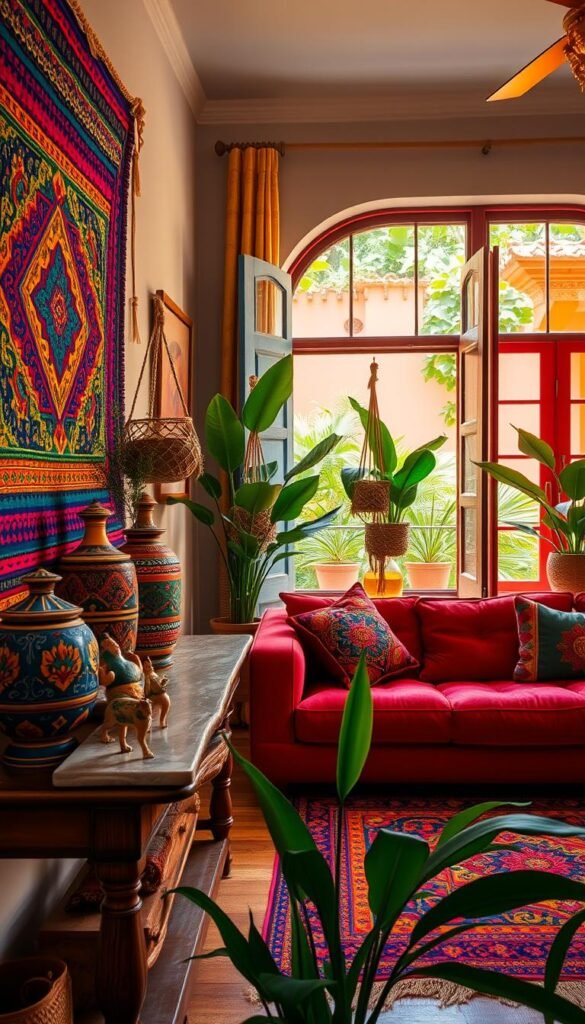
Mexican Folk Art and Talavera Ceramics
Mexican folk art is famous for its bold colors and detailed patterns. It’s great for adding life to any room. Talavera ceramics, with their bright glazes and traditional designs, bring a bit of Mexico to your kitchen or dining area. These pieces make any space warm and welcoming.
Brazilian Tropical Modernism and Natural Elements
Brazilian design celebrates nature’s beauty. Adding natural elements like woven fibers, plants, and stone creates a tropical feel at home. It also uses bold colors and sleek lines for a modern touch.
Peruvian Textiles and Andean Color Schemes
Peruvian textiles are known for their detailed patterns and bright colors. They reflect the Andean region’s rich culture. Using these textiles in your decor, like throw pillows or blankets, adds color and cultural interest. The Andean color scheme, with its earthy tones and bright accents, helps create a beautiful and cohesive design.
By using these diverse design elements, you can make your home both beautiful and culturally rich. Whether you love the bold colors of Mexican art or the natural beauty of Brazilian design, there’s something for everyone in Latin American style.
Middle Eastern Opulence and Intricate Patterns
Middle Eastern design is all about its detailed patterns, bright colors, and rich textures. These elements can turn any room into a luxurious retreat. I find it fascinating how they blend to make a space both unique and glamorous.
Geometric Masterpieces in Tiles and Textiles
Moroccan geometric designs are a key part of Middle Eastern style. They feature complex patterns and bold colors, adding a striking look to any room. I enjoy using these designs in tiles, textiles, and decor to make a space visually stunning.
For example, a Moroccan tile can be a standout piece. It brings color and pattern to a simple room.
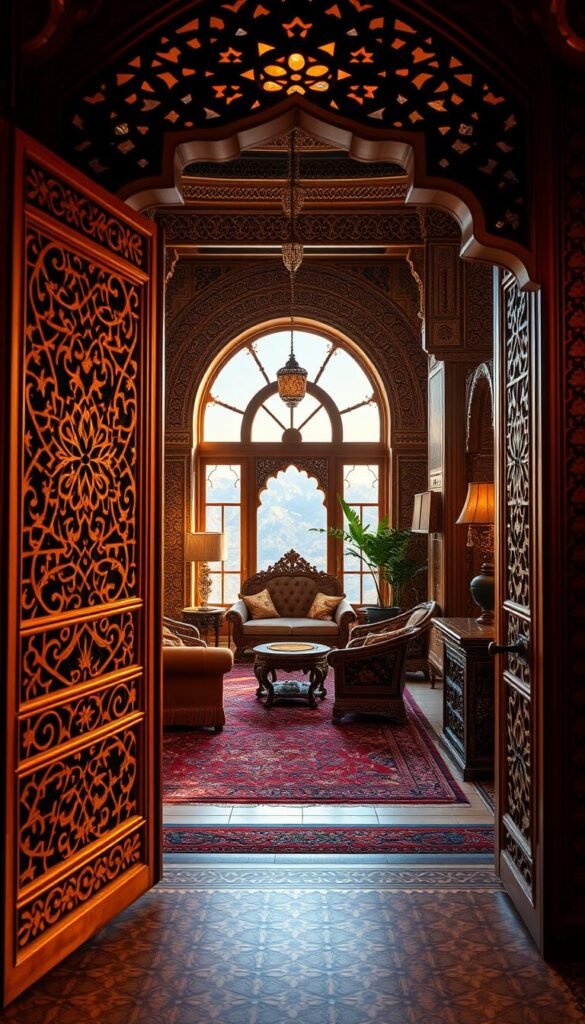
The Timeless Elegance of Persian Rugs
Persian rugs are famous for their detailed patterns, rich colors, and fine craftsmanship. I love using them as focal points in a room. They instantly make the space feel more elegant and sophisticated.
Whether you pick a classic or modern design, a Persian rug adds warmth and depth to your home.
Illuminating Spaces with Turkish and Arabic Lighting
Turkish and Arabic lighting is known for its ornate metalwork, detailed patterns, and warm light. I enjoy using these pieces to add a touch of Middle Eastern luxury to a room. They create a cozy, inviting atmosphere perfect for relaxing or hosting guests.
From pendant lamps to table lamps, these fixtures bring a sense of global design trends and inspiration to your space.
Indigenous North American Design Elements
Indigenous North American design focuses on natural materials and symbolic patterns. It’s a rich source of inspiration for adding ethnic home decor. This design comes from Native American culture, where every item tells a story.
Symbolism in Native American Patterns
Native American patterns are more than just pretty; they carry deep meanings. For example, the Navajo rug shows stories of nature, ancestors, and spiritual beliefs. Quapaw and Choctaw tribes use basket weaving to share messages and show their tribe.
- Geometric shapes symbolizing natural elements like the sun, moon, and water
- Animal motifs representing strength, protection, and guidance
- Floral designs signifying growth, renewal, and the connection to the earth
Natural Materials and Earth-Conscious Design
Indigenous North American design values natural materials and caring for the earth. Using wood, stone, and clay adds warmth and shows a commitment to sustainability.
- Using reclaimed wood for furniture and flooring
- Incorporating stone or clay pottery as decorative pieces
- Opting for natural fiber textiles like wool and cotton
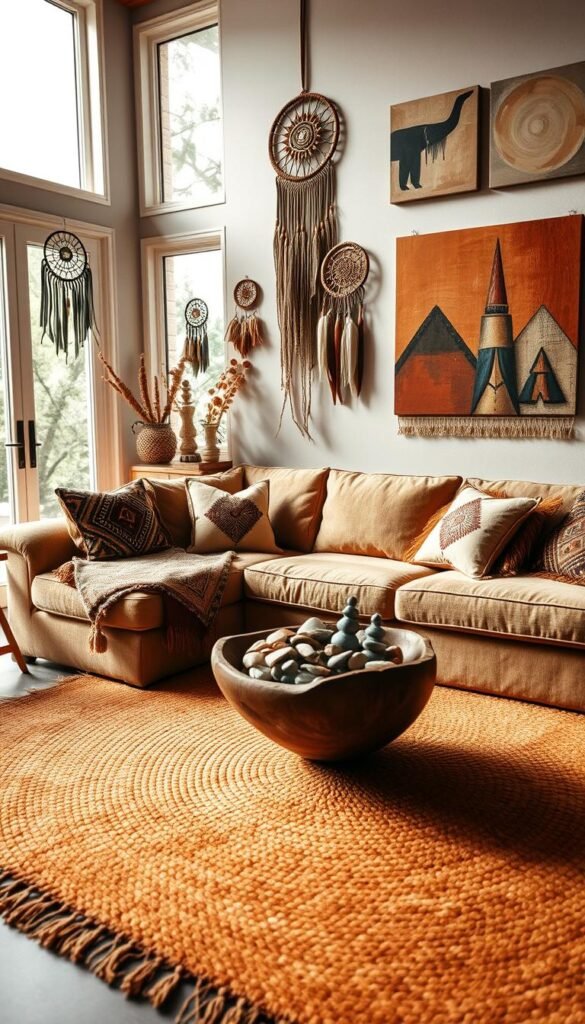
Creating Balanced Fusion Spaces with Ethnic Interior Design
I love mixing different cultural elements in my home decor. It’s exciting to share how to make a space that’s both interesting and rich in culture.
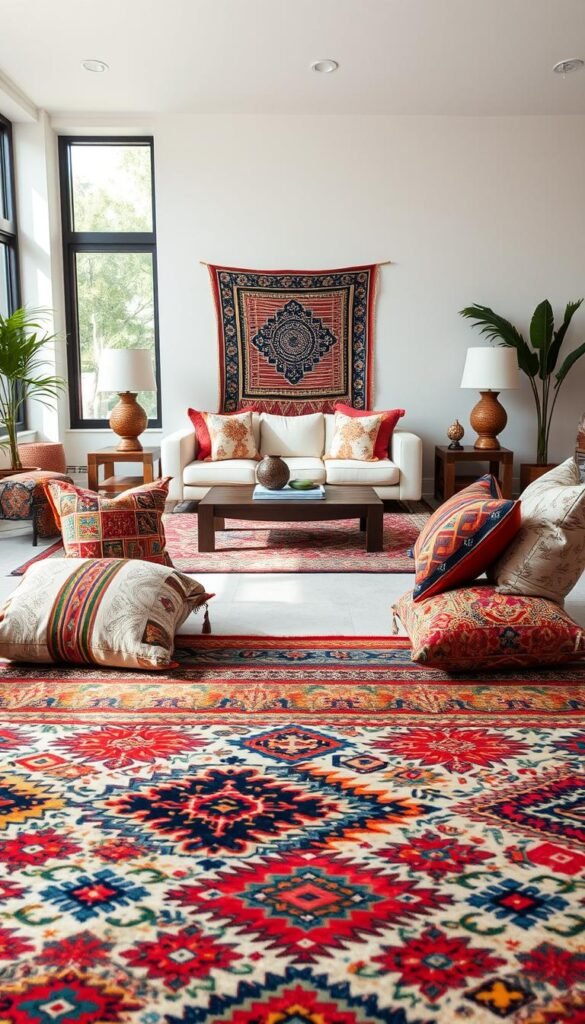
To create a balanced space, it’s key to know how to mix cultural elements well. You need to pick pieces that match in style, texture, and color.
Techniques for Mixing Cultural Elements Harmoniously
When mixing cultural elements, remember the 5 key principles:
- Choose a unifying theme or color palette.
- Balance bold patterns with neutral backgrounds.
- Mix different textures to add depth.
- Use statement pieces to create focal points.
- Ensure that each element is respectful and authentic.
Color Theory Across Cultural Boundaries
Color is very important in ethnic interior design. Different cultures see colors differently. For example, white means purity in the West but mourning in Asia.
By knowing these differences, you can pick colors that are both beautiful and respectful.
Focal Points and Statement Pieces from Around the World
Adding unique pieces from different cultures can make your space special. Think about using traditional African masks, Indian block-printed textiles, or Moroccan tiles as highlights. These pieces not only look great but also share stories, making your space more personal.
Sustainable Approaches to Global Design
The future of ethnic interior design blends global style with sustainability. When we add elements from different cultures to our homes, we must think about their environmental and social effects.
I love bringing global style into our homes in a way that’s good for the planet. Supporting artisans through fair trade is key. It helps preserve cultural heritage and improves the lives of local communities.
Supporting Artisans Through Fair Trade Practices
Fair trade ensures artisans get paid fairly for their work. This helps keep their cultures alive and supports their families. By choosing items with fair trade labels, we help artisans worldwide.
Annie Leibovitz once said,
“The world is a book, and those who do not travel read only one page.”
This quote is perfect for global design. It encourages us to explore and value different cultures.
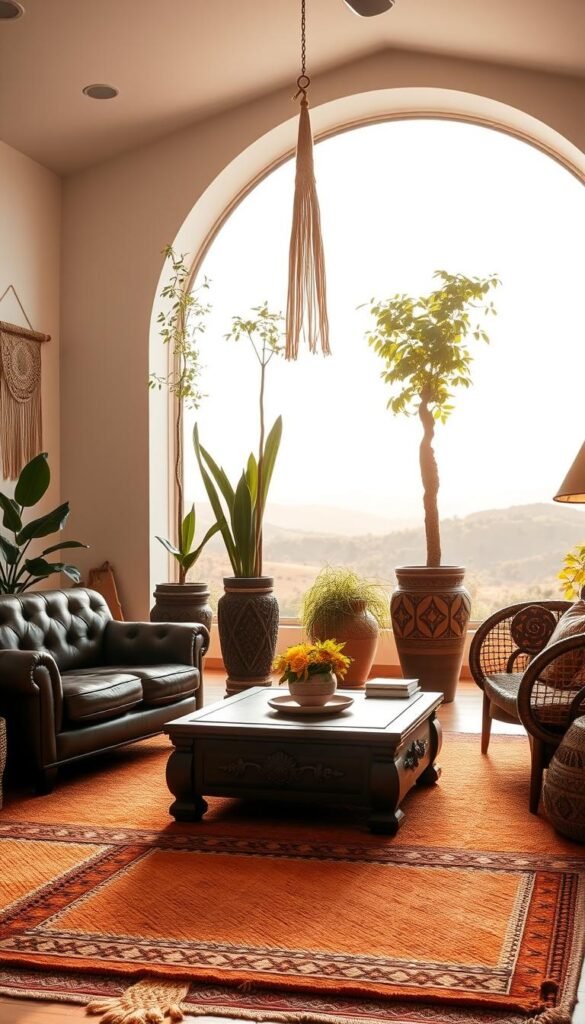
Upcycling and Repurposing Traditional Items
Upcycling and repurposing are great for reducing waste in ethnic interior design. They give old items a new life, adding unique charm to our spaces. For example, turning an old Moroccan tile into a wall hanging or using vintage Indian fabrics for upholstery brings global flair to our homes.
By adopting sustainable global design, we create spaces that are both beautiful and culturally rich. These spaces reflect our style and help make the world a better, more sustainable place.
Ethnic Design Elements for Different Room Types
Interior design is more than looks; it’s about telling a story and celebrating cultures. Different cultures offer a wealth of inspiration for our homes. By adding ethnic design elements to various rooms, we can create a space that reflects our style and love for global cultures.
Living Spaces That Tell Cultural Stories
Living rooms are the heart of the home, where memories are made. Adding ethnic design elements here sets the tone for the whole house. For example, an African mud cloth can bring color and cultural significance to your living room.
“Design is not just about making things look pretty; it’s about creating an experience,” says a renowned interior designer. Think about adding sculptural furniture or decorative masks. They not only beautify but also tell a story of their origin.
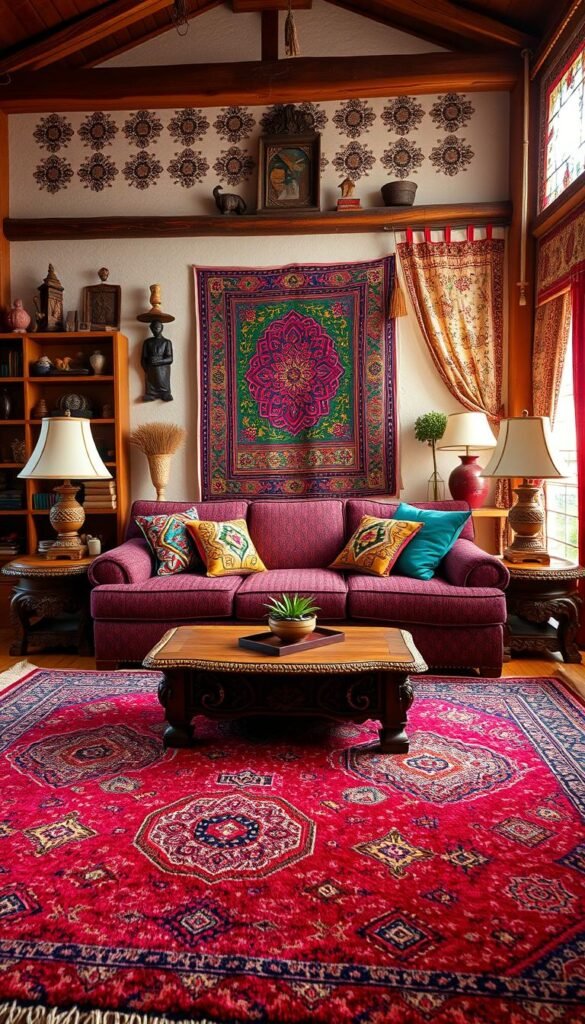
Bedrooms Inspired by Global Sleep Sanctuaries
The bedroom is a place of rest and rejuvenation. Drawing inspiration from global sleep sanctuaries can make it a serene retreat. For instance, Japanese minimalism with tatami mats and shoji screens can create a peaceful ambiance.
Or, rich textiles and patterns from India or Morocco can add depth and interest. This makes the bedroom a cultural haven.
Dining Areas That Celebrate Communal Traditions
Dining areas are where communities come together. They’re more than just spaces to eat. Adding ethnic design elements can turn these spaces into vibrant celebrations of communal traditions.
Consider using Peruvian textiles or Mexican folk art for color and cultural significance. The key is to balance these elements with your home’s overall aesthetic. This creates a harmonious fusion that honors different cultures.
Conclusion: Creating a Home That Honors Global Heritage
I love adding ethnic interior design to my home. I’m excited to share this journey with you. By embracing diverse design and honoring cultural heritage, we can make a space that’s beautiful and meaningful.
Cultural decor and ethnic home decor offer endless inspiration. From African mud cloth to Indian color theory, and from Latin American vibrancy to Middle Eastern opulence, each culture adds its own unique touch.
To create a harmonious space, balance different cultural elements. Start with a few statement pieces that speak to you, then build upon them. This way, you’ll make a home that celebrates global heritage and cultural diversity.
As you start this design journey, remember to appreciate and respect the cultural background of each element. This way, you’ll not only create a stunning space but also help preserve cultural heritage. Let’s celebrate the richness of global cultures and create homes that honor this heritage.
To bring you cozy inspiration more efficiently, we sometimes use AI to assist in content creation — but every word and idea is carefully shaped by our team. See our AI Disclosure for more info.

